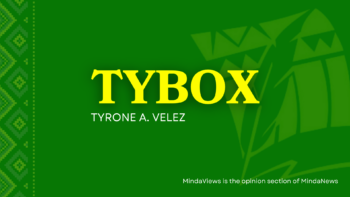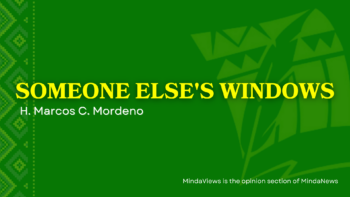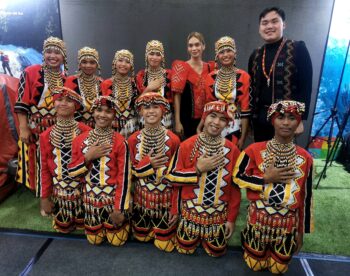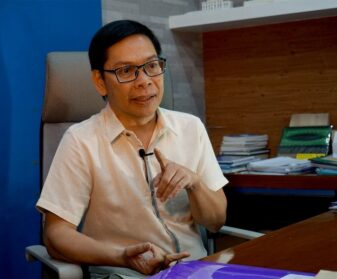
BOOK REVIEWS
- TINUBDAN: New Voices from Northern Mindanao – A Literary Anthology
Editors: Arlene J. Yandug, Maria Elena L. Paulma and Lilia A. Coterjar
Xavier University – Department of English Language and Literature, 2021 - THE UNTOLD STORIES OF CAMIGUIN ISLAN
Author: Andres Narros Lluch
Xavier University Press, 2020
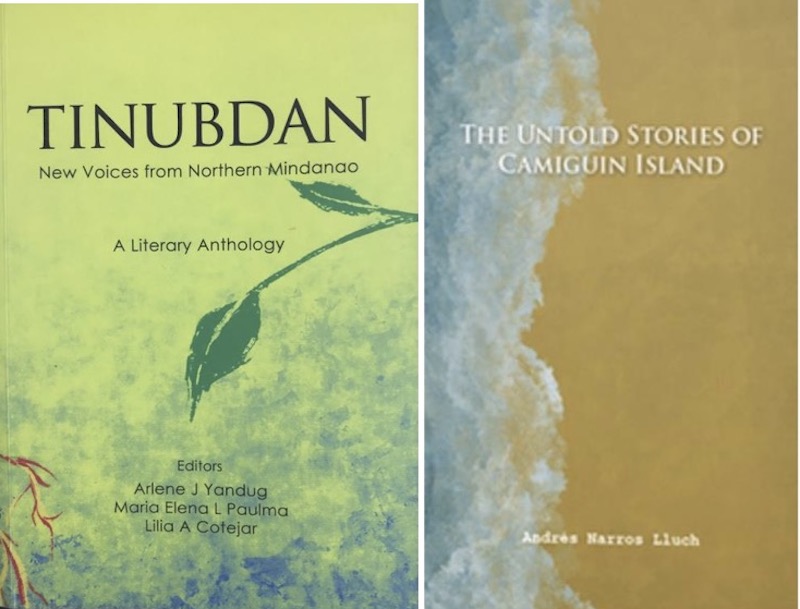
Considering Mindanao’s location in this tropical part of the world with is mountain ranges, tubods or watersheds are a natural part of its landscape. Despite the massive onslaught of logging operations that have devastated its ecosystem owing to the endless deforestation, there are still pockets across this part of southern Philippines with remaining watersheds.
The sad occurrence of the disappearing forests took place side by side with the increasing migration from mostly Cebuano-Bisayan-speaking regions of the archipelago, many of whom came in search of livelihoods provided by business firms such as logging corporations unless their main concern was to acquire a piece of land to till. In time, the island’s dominant language would introduce into the Mindanawon lexicon a word such as tubod.
Where there is a watershed, it is not surprising that such a place would carry the name Tubod. The capital town of Lanao del Norte bears this name. And from the word tubod, a derivative, namely tinubdan (the watershed’s source), is now appropriated by a group of authors to name an anthology of their writings.
TINUBDAN is a collection of mainly poems, essays and short stories both in English and Cebuano-Bisaya, contributed by 21 writers from Northern Mindanao, the region comprising Bukidnon, Camiguin, Lanao del Norte, Misamis Occidental and Misamis Oriental and is published by the Department of English Languages and Literature of Xavier University, Cagayan de Oro City. It is edited by Arlene J. Yandug, Maria Elena L. Paulma (both with a PhD in Creative Writing) and Lilia A. Coterjar (PhD in English Language and Literature).
From the authors’ Introduction to the book with its declarative title – “Getting to the Sources: Initial Notes on Literary Anthologizing vis-à-vis the Narrative of the Region” – one can immediately deduce that those behind this book have a decolonial intent challenging the dominance of Western literature in our country followed for a while by those from the Republic’s neo-colonial center. They make this forceful assertion to underscore a local slant:
“(T)he team has thoughtfully retained the scope of the project for in the light of the nation-region discourse (where ‘region’ implies being overshadowed by the nation-center which dictates the tempo of literary production), we believe the places where we were born or raised in are the true sources or wellsprings of our literary expressions. And that small, multifarious compiling is the way to go in Philippine literature as it is more likely to ferret out hidden, underrepresented literary imagination, writing gestures, and consciousness.”
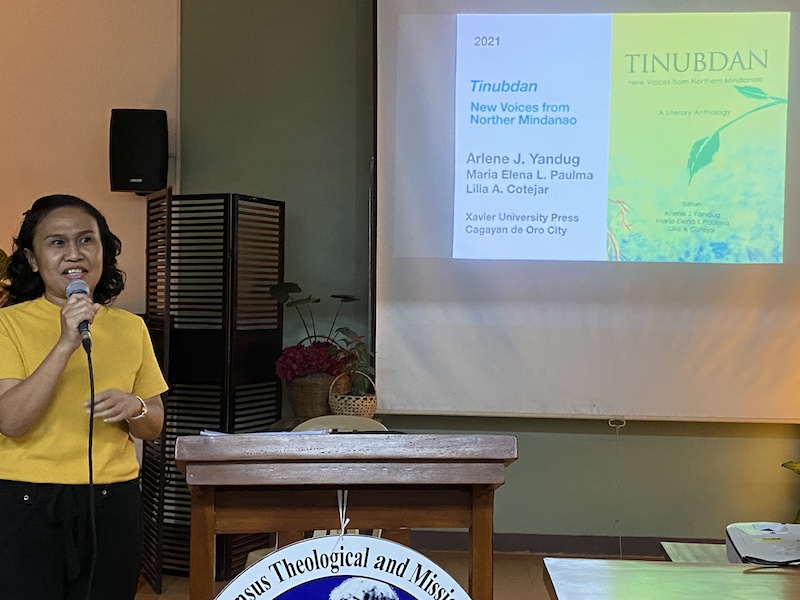
The local versus the global, the center versus the periphery, the indigenous versus the Western, the dominant over the dominated. For years now, these dualities have been challenged by those constructing and/or promoting post-colonial as well as decolonial theories both in the social sciences and literature circles. Authors, writers and journalists are naturally the most vociferous in the appropriation of these theories as they are the most assertive in speaking their voices through the written word!
This Introduction is in itself an essay detailing how this assertion has unfolded across Mindanao in the past decades, especially in two hubs, namely the south (especially in Davao City) and the north (bridging the cities of Iligan and Cagayan de Oro). Publications after publications are then cited and documented in footnotes to indicate how this history of contemporary Mindanawon writing – especially as compiled in anthologies – has unfolded through the years. The authors name the pioneers in this field and how they paved the road for the Gen-Z Mindanawon writers who are now exploring this creative field.
The 2nd Mindanao Book Festival has clearly shown how far this movement to produce and promote Mindanawon writings has reached, despite the odds. While there has been a growing number of published works by Mindanawons about Mindanao, there could be more if only there were more local publishing houses with the capital to publish more books. Authors with unpublished works are desperately waiting for the chance that their manuscripts could be published.
There are other factors to consider: printing costs in this country are quite expensive (thus even the middle class academicians find it difficult to buy books), academic institutions (even universities) are not too keen in having more titles published (again for financial reasons or because the decision-makers are not book-lovers), marketing systems are still to be set up so the books reach its intended audiences. Government agencies (despite grants from CHED) not only heavily tax book publishing but has only a pittance for grants to publish books (unless they are peddled by relatives of those in DepEd cashing in on textbooks, as was the case during the Erap Estrada administration).
In this scenario, how can we introduce more millennials and Gen-Zs who have the gift to become writers into this field with the hope that, one day, they, too, could be published? It must be so daunting for them especially if we add another contemporary reality, namely, that the youth today are being drawn more to images in their technological gadgets resulting in just a few who enter libraries or read required texts for their classes. One can only wish that – like their elders – they would not yield to the tendency to just give up on their dream of becoming published authors!
But perhaps, all is not lost. The youthful crowd who flocked to the MindaBookFest II shows there is an interest out there. And TINUBDAN’s appearance in this BookFest’s collection is a clear testament that Mindanawon works still have a bright future!
Adding to Northern Mindanao’s contribution to this exhibit (apart from the works of Christine Godinez-Ortega, Tibo Fernandez and others) is Andres Narros Lluch’s The Untold stories of Camiguin Island (XU Press). Indicating that small islands such as Camiguin in southern Philippines can also be a rich reservoir of stories, Lluch follows the tradition paved earlier by the likes of H. Arlo Nimmo whose The Songs of Salanda and Other Stories of Sulu (ADMU Press, 1994) prove that anthropologists can also be popular story tellers.
Lluch veers away from Nimmo’s work by writing stories which are fictional but based on historical facts. Which was why he took the pains of not only immersing himself in the terrains and communities across this small island but did extensive archival research. In his Bibliography, he listed the archives of the Archivo Recoletos de Filipinas in Manila and in Navarra, Spain, those of XU (colleccion personal e Vicente Elio), the National Archive of the Philippines (Erreccion de Pueblos Camiguin), and the Portal de Archivos Espaňoles (Diario de Navegacion de Legazpi a Filipinas).
In his Dedication, he especially mentions Father Calisto Gaspar, who was parish priest of Catarman on Camiguin Island in 1884 whose reports and writings for over a decade titled Remarkable Things in Camiguin served as a rich resource of information. While these four fictionalized stories arose out of the author’s imagination, historical reality and fiction intermingled in the texts. The author provides a few pages of Clarifications for the readers’ benefit. Drawings by Melissa Abuga-a also help provide the pages its added attraction.
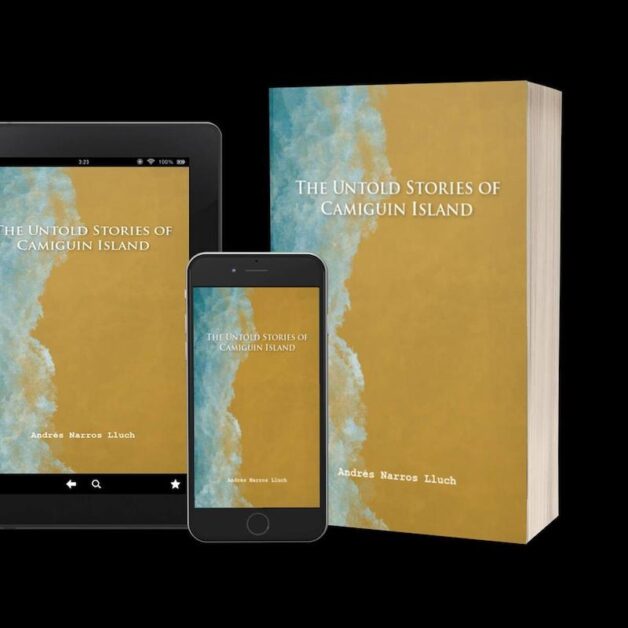
In the first of the four stories – Kimigin – the author allows the readers a journey through time going back to the Spanish period until today while providing them with a profile of current ethno-historical knowledge about the original settlers of this island-volcano (the Kimigin tribe) and the first migrants to settle (the Bisaya people). In Punta Pasil, the readers are provided a glimpse into the complex encounter between the Europeans and the native inhabitants (and how Christianity pushed away the animist gods). Datu Mehong is a story that explores the legend of the leader Apo Mehong Bacuňata, recounting his skills as healer and warrior. And The New Volcano recalls how an old man was marginalized by the maneuverings of the ecclesiastical powers occurring during the time when the Old Volcano erupted in 1871.
For most of us, Camiguin Island is more popularly known as a tourist destination, rarely perceived to have a rich historical and cultural heritage. But Lluch offers the visitors his own view of what to expect when they visit the island: “Today, anyone who strolls along its village streets and chats with the locals or takes a hike within its forests could liken the experience to a museum visit where the past is still, however subtly, engraved on its lands and edifices.” And if one stands under that fabulous waterfalls, one can exhilaratingly experience the joy of the waters that flow from the island’s watersheds.
Tinubdan and The Untold Stories of Camiguin Island – no matter if Tinubdan’s editors refer to these as just a “modest contribution” – constitute a “tributary which hopefully grows in substance in future works, as the writers persevere to give words to a call forever haunting them!”
[MindaViews is the opinion section of MindaNews. Redemptorist Brother Karl Gaspar is a professor at St. Alphonsus Theological and Mission Institute (SATMI) in Davao City and until recently, a professor of Anthropology at the Ateneo de Davao University. Gaspar is Mindanao’s most prolific book author. He writes two columns for MindaNews, one in English (A Sojourner’s Views) and the other in Binisaya (Panaw-Lantaw). Gaspar is a Datu Bago 2018 awardee, the highest honor the Davao City government bestows on its constituents.]
WATCH: Virtual Book Launch of “The Untold Stories of Camiguin Island”
15 April 2021
Start at 21:22

